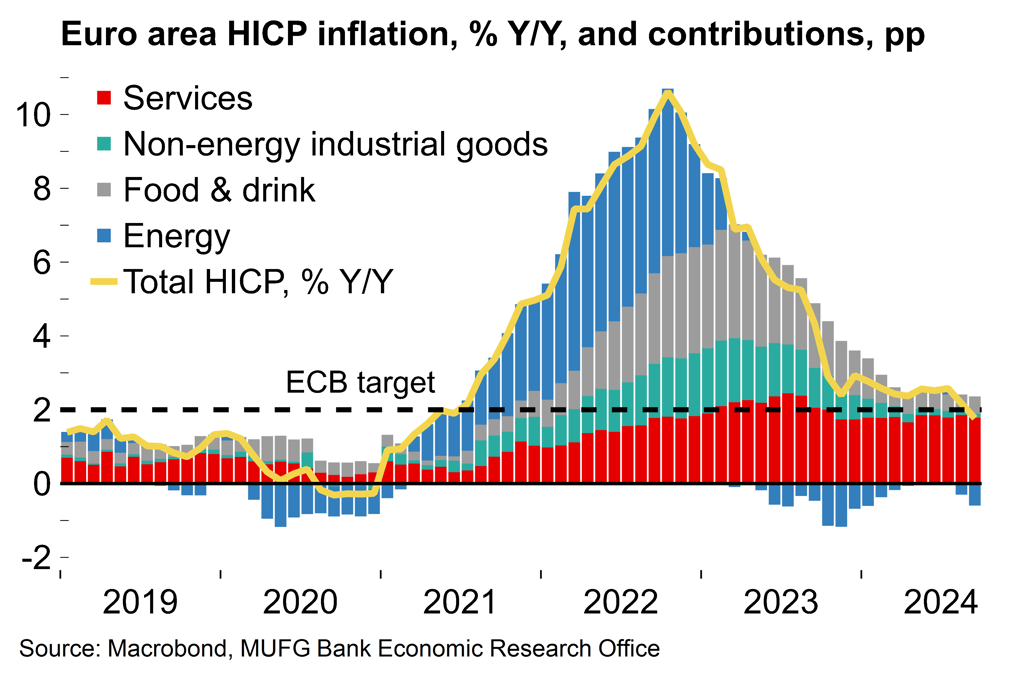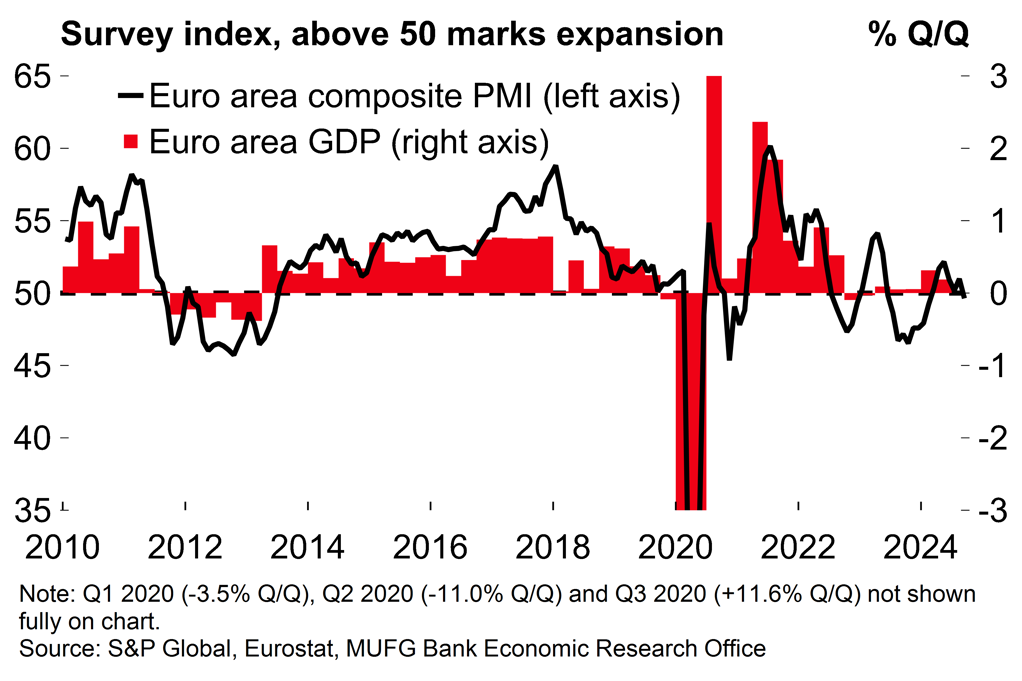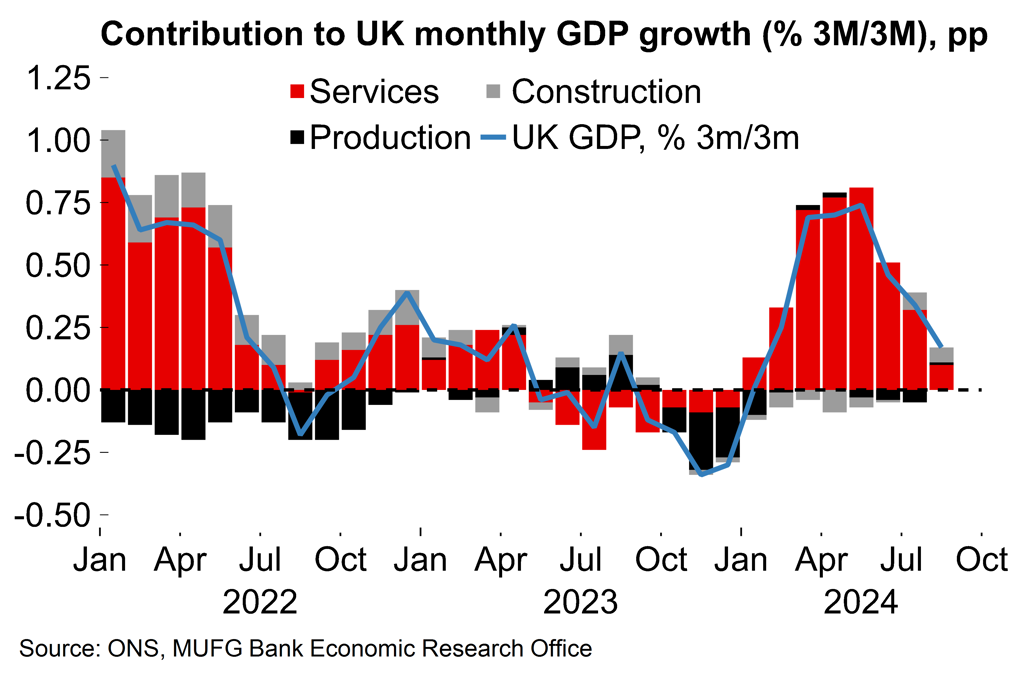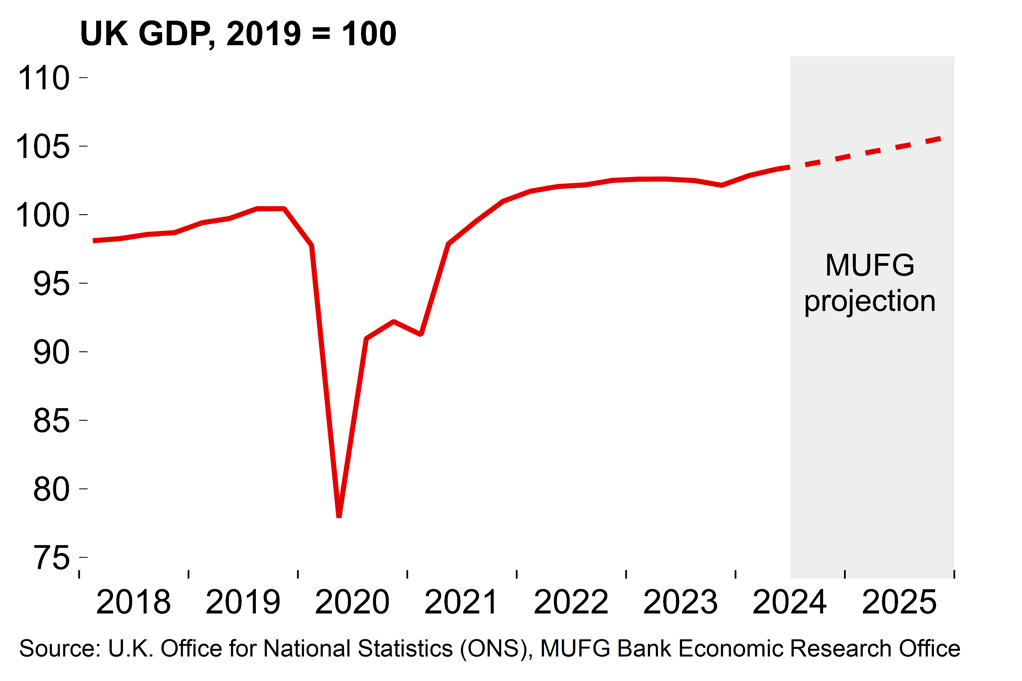- Recent data releases have almost uniformly supported a faster pace of easing from the ECB and officials have duly suggested a willingness to go back-to-back with rate cuts. There is no obvious reason to wait until December and policymakers would risk losing credibility if they didn’t act now after emphasising data dependence. That said, the message is likely to be one of an orderly recalibration in response to incoming data rather than any urgency to make up for lost ground with the ECB not yet ready to declare victory over inflation.
- In the UK, growth has slowed markedly since the strong start to the year and sentiment has softened after the government invited speculation around the extent of incoming fiscal consolidation. However, taking a wider view, we think that the UK economy remains in reasonable shape and that the expansion will settle into a more sustainable pace once the Budget period has been navigated.
ECB preview: The data demands it
The ECB cut rates at its last meeting in September. There was no fresh guidance – the message was that the flexible, data-dependent approach would continue. If anything, it seemed as though the bar was quite high for a back-to-back move at the October meeting. Lagarde highlighted the short period between decisions (just five weeks) and highlighted that the September inflation rate was likely to fall before rising again later in the year. The steer seemed to be: yes, we are data-dependent, but don’t expect us to react suddenly to a handful of incoming figures.
Since then headline inflation in September has fallen below target to 1.8%. That is the lowest rate in three and a half years and left Q3 average inflation a tick below the ECB’s September projection. Survey data has also underscored that the economy is losing steam. The composite PMI slipped below the breakeven mark last month, for the first time since February. We said at the time that the ECB’s latest euro area GDP projection (0.8% in 2024) looked optimistic and that sense has only increased (we have 0.7% and acknowledge risks are tilted to the downside). In short, while there hasn’t been a huge amount of releases since the last meeting, the data that has been released has almost entirely moved in the right direction from a monetary policy perspective.
Policymakers have duly changed their tune (see here). Last week Lagarde spoke to a European Parliament Committee and acknowledged that recent developments strengthen the ECB’s confidence that “inflation will return to target in a timely manner” and that policy makers will “take that into account” at the next meeting. Executive Board member Isabel Schnabel, who tends to be a more hawkish voice, said that a sustainable return of inflation to target “is becoming more likely”, with that sentiment echoed by various Governing Council members as well. Market participants moved to almost wholly price in a rate cut next week and there’s been no attempt from officials to push back on this prior to the pre-meeting quiet period.
The simple reality is that the ECB has emphasised its data dependence and recent news has almost uniformly supported a faster pace of easing. Our view is that the ECB would risk losing credibility if it didn’t act and there doesn’t seem to be any reason to wait until December.
Chart 1: Inflation has now fallen below target

Chart 2: Euro area growth momentum is faltering

In terms of communication, we expect the ECB will stress that the accelerated pace of easing is an orderly recalibration in response to incoming data rather than a sign of an urgent need to make up for lost ground. The minutes from the September meeting (here) were only released yesterday. The key sentence was probably that “the risk of undershooting the target was now becoming non-negligible”. However, there was a clear sense that officials are not yet ready to declare victory over inflation – “it was emphasised that core inflation was very persistent” and that the “outlook for services inflation called for caution”. Given that, we think the ECB will look to stay flexible and we doubt there will be any move to set out an expected easing schedule at this point.
Looking ahead, the December meeting looks like a more likely juncture for a more meaningful shift in communication. There will be a wide range of key data points between now and then which will provide greater clarity on the persistence of underlying inflation. Our base case is that the ECB will now go back-to-back before reverting back to a quarterly pace of rate cuts, at projection meetings, next year as rates approach upper estimates of ‘neutral’ and consumer demand improves. That would take the deposit rate to 2% by year-end which is the mark we’ve pencilled in as the terminal rate. But, for now, flexibility will remain the order of the day and we expect policymakers will continue to emphasise their data-dependence while looking to downplay the significance of any acceleration in easing.
UK growth is settling at a more sustainable pace
The UK economy started the year with a bang but it’s clear that growth momentum has faded since the summer. Monthly GDP is estimated to have expanded by 0.2% in the three months to August, in line with expectations. That marks a clear slowdown on average quarterly growth of 0.6% across Q1 and Q2. However, stronger growth earlier in the year was supported by one-off factors such as the decrease in public sector strike action. Our view is that growth has now settled into a more sustainable pace. Today’s release showed that the expansion, while slower, was broad-based across sectors with particularly encouraging signs of stronger construction activity.
There could be some short-term volatility in the monthly figures over coming months. The government has undermined its pre-election pledge to restore calm and stability by inviting speculation around the extent of incoming fiscal consolidation. Soon after the election in early July, the government announced that its first Budget would be held on 30 October and since then the prime minister, Keir Starmer, gave advance notice that measures are likely to be “painful” in an attempt to pin problems on the previous administration. To no great surprise, consumer confidence has duly weakened sharply and business sentiment has also softened. That could see spending and investment decisions delayed until after the Budget and hence weak growth in the run-up to the announcement.
Chart 3: UK growth has slowed markedly in recent months

Chart 4: Our view remains that the economy has exited its period of stagnation and will continue to expand

We’d stress that the overall extent of any fiscal consolidation remains unclear. Yes, it looks like the government will implement a range of tax rises to balance day-to-day spending requirements – but it also seems set to carve out extra space for investment expenditure. If the government can navigate this without spooking market participants then the pledge to restore stability will become more plausible – a steady policy environment for the next four and a half years until the next election would certainly be welcome after the turbulence of the Brexit years.
In terms of the wider growth picture, we still believe that the acceleration at the start of the year marked an inflection point after an extended period of stagnation. Taking a step back from Budget-related noise, the UK economy remains in reasonable shape. Business surveys, while softer, are still consistent with growth at around potential rates (~0.35% Q/Q) through the second half of the year. The fundamentals for households remain particularly encouraging with headline inflation likely to fall below target next week, well below nominal wage growth, and savings buffers having been replenished. The BoE has indicated that it might take a more “activist” approach to rate cuts which could provide another tailwind to growth. Overall, we are tracking annual average GDP growth at around 1% in 2024 and 1.5% next year.
GDP & CPI forecasts


